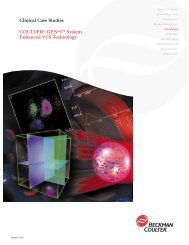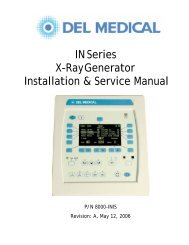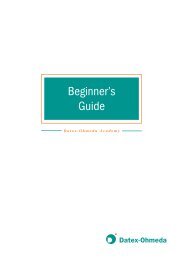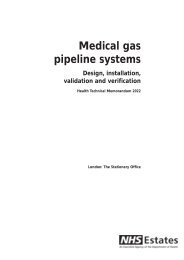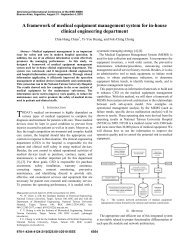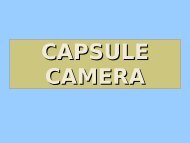Electrosurgery Self-Study Guide
Electrosurgery Self-Study Guide
Electrosurgery Self-Study Guide
You also want an ePaper? Increase the reach of your titles
YUMPU automatically turns print PDFs into web optimized ePapers that Google loves.
<strong>Electrosurgery</strong> <strong>Self</strong>-<strong>Study</strong> <strong>Guide</strong><br />
Objectives<br />
Upon completion of this activity the participant will be able to:<br />
4<br />
1.) Relate the properties of electricity to the clinical<br />
applications of electrosurgery.<br />
2.) Review four of the variables the surgeon controls<br />
that impact surgical effect.<br />
3.) Discuss the relationship between current<br />
concentration and tissue effect.<br />
4.) Identify potential patient injuries related to electro<br />
surgery and technological advances designed to<br />
eliminate these problems.<br />
Accreditation<br />
Statements<br />
This activity has been planned and implemented in<br />
accordance with the Essentials and Standard of the<br />
Accreditation Council for Continuing Medical Education by<br />
Valleylab. Valleylab is accredited by the ACCME to provide<br />
continuing medical education for physicians<br />
Valleylab designates this educational activity for a<br />
maximum of 2 hours in Category 1 credit toward the AMA<br />
Physician’s Recognition Award. Each physician should<br />
claim only those hours of credit that he/she actually spent<br />
in the educational activity.<br />
This offering for two (2) contact hours was designed by the<br />
Clinical Education Department of Valleylab, which is an<br />
approved provider of nursing continuing education (CE) in:<br />
Colorado: Valleylab is approved as a provider of<br />
continuing education in nursing by the<br />
Colorado Nurses’ Association, which is<br />
accredited as an approver of continuing<br />
education in nursing by the American<br />
Nurses Credentialing Center’s<br />
Commission on Accreditation.<br />
Additional Valleylab provider numbers:<br />
California: #CEP 12764<br />
Iowa: #289<br />
Florida: #27I1796<br />
Kansas: #LT0134-0327<br />
Disclaimer Statement<br />
CNA “approved” refers to recognition of educational<br />
offerings only and does not imply approval or<br />
endorsement of any product of Valleylab.<br />
A certificate of completion pertains only to the participant’s<br />
completion of the self-study guide and does not, in any way,<br />
attest to the clinical competence of any participant.<br />
Verification of<br />
Completion<br />
A certificate will be provided to each person who<br />
completes the offering. The certificate pertains only to<br />
completion of the offering and is intended for recordkeeping<br />
purposes.<br />
Instructions<br />
1. Complete the test questions and check the correct<br />
responses with the key. A score of 70% or better is<br />
recommended. Please review the self-study guide<br />
portions related to missed questions, if necessary.<br />
2. Complete the registration form.<br />
3. Complete the evaluation form.<br />
4. Send the completed registration/evaluation form<br />
with the test question responses and $15.00 fee to:<br />
Clinical Education Department A50<br />
Valleylab<br />
5920 Longbow Drive<br />
Boulder, CO 80301-3299<br />
For information call: 800-255-8522 EXT. 6240<br />
5. Upon receipt of the required documents a certificate<br />
of completion for two (2) credit/contact hours will be<br />
sent. Please allow 3–4 weeks for the certificate to be<br />
mailed after submission of required paperwork.<br />
Valleylab will maintain a record of your continuing<br />
education credit and provide verification if necessary<br />
for five (5) years.<br />
Expiration Date<br />
This offering was originally produced for distribution in<br />
September 1997. It was revised in September 1999 and<br />
cannot be used after September 2002 without being<br />
updated. Therefore, credit will not be issued after<br />
September 30, 2002.<br />
Note: The terms listed in the glossary are printed in bold in<br />
the body of the text of the self-study guide.<br />
Key Concepts<br />
Electricity can be hazardous. Understanding how<br />
electricity behaves and relates to electrosurgical function<br />
and applications can contribute to its safe use. Many<br />
different types of electrosurgical technologies are in use in<br />
the surgical setting. The surgeon, perioperative nurse and<br />
other healthcare team members must be aware of the<br />
implications for use for each technology in order to ensure<br />
safe patient care.



